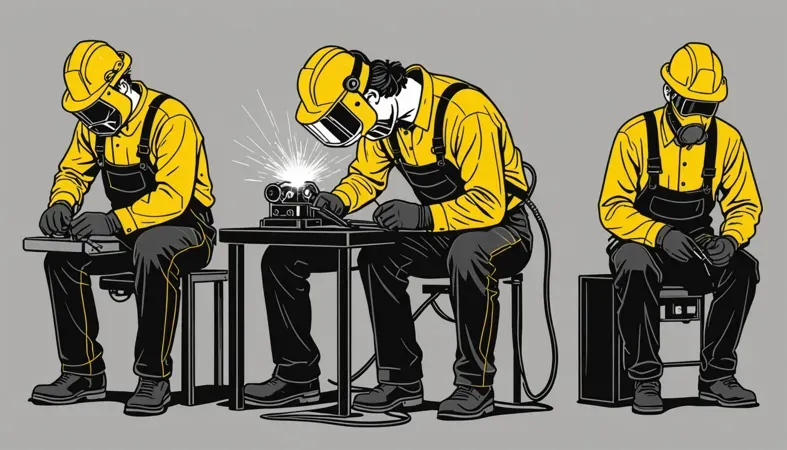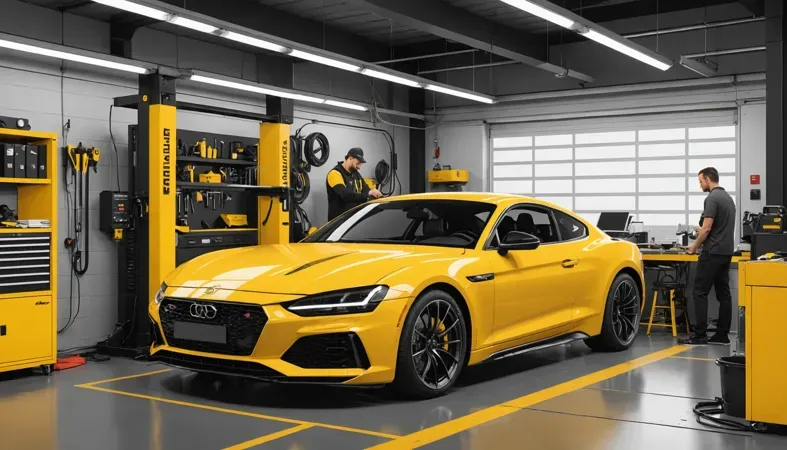How to Set Up Lincoln Electric Welder? Setup Steps, Types, and FAQs
Published on: February 9, 2025 | Last modified: March 4, 2025
By: Joe Carter
A Lincoln Electric welder is a powerful tool used for welding metal. It’s known for its durability and efficiency, making it a favorite among professionals and DIY enthusiasts alike.
I often used to be asked how to set up lincoln electric welder. It’s crucial to follow the right steps to ensure safety and achieve quality welds. From my experience, a proper setup prevents frustration and helps improve your overall welding skills.
In this guide, we’re going to cover what a Lincoln Electric welder is, its various types, essential steps for setup, factors affecting the setup, and common FAQs. You’ll learn valuable tips on how to use a Lincoln MIG welder, how to set up Lincoln 140 welder, as well as advice on fixes and updates. Let’s dive in!
Contents
How to Set Up Lincoln Electric Welder?
A Lincoln Electric welder is a reliable tool for welding tasks. To set up the Lincoln Electric welder, follow the manual, connect your gas (If Needed), and adjust your settings correctly. It’s typically easy for beginners and useful for projects like metal fabrication. Mastering techniques such as welding 45-degree angles can significantly enhance your projects in metal fabrication. Explore the detailed steps for welding 45-degree angles.
What is Lincoln Electric Welder?
The Lincoln Electric welder is a high-quality welding machine designed for efficiency and reliability. It operates using various processes, including MIG (Metal Inert Gas) and TIG (Tungsten Inert Gas) welding. These machines typically range from 125 to 280 Amperes, capable of welding materials up to 5/16 inches (8 Mm) thick. With a duty cycle of about 20% at 130 Amperes, this welder can run continuously for 2 minutes out of every 10 before needing to cool down.
Setting up the Lincoln Electric welder isn’t too tricky, but it requires patience. First, you’ll need to select the right MIG or TIG wires based on the metal type. I’ve encountered issues when I didn’t double-check these details. A well-configured welder saves you time and energy during your projects!
I’ve used the Lincoln Electric welder for various small repairs. It’s impressive how a steady hand and the right settings can significantly improve your welds. When using a Lincoln MIG welder, I found that the settings vary based on material thickness and type. Understanding these settings helps ensure smoother welds and minimizes spatter!
Types Of Lincoln Electric Welders
What types of Lincoln Electric welders can you set up?
-
Stick Welders
Stick welders are great for heavy-duty tasks. To set up, connect the electrode holder to the positive (+) terminal and attach the ground clamp to clean, bare metal for a strong connection.
-
MIG Welders
MIG welders use a wire feed system and gas for easy welding. To set up your Lincoln MIG welder, load the spool of wire into the drive assembly, connect the gas cylinder, and adjust the flow rate to about 20 to 25 cubic feet per hour (Cfh). It’s crucial for welders to understand what different electrode classifications mean to improve their welding precision.
-
TIG Welders
TIG welders provide high precision for thin metals. To set up, connect the tungsten electrode to the torch and set the gas flow rate at about 15 to 20 cfh. Adjust the amperage based on the thickness of the material. When welding it is crucial to know how to treat welding burns.
-
Multi-process Welders
Multi-process welders support stick, MIG, and TIG welding. To set up, select the mode on the machine that matches your task, then adjust the polarity as needed based on the welding process.
-
Flux-cored Welders
Flux-cored welders are ideal for outdoor work. To set up, load the flux-cored wire and configure your machine’s manual settings for voltage and wire feed speed based on the material—typically around 50 to 70 amps. Ensuring safety during welding is crucial and understanding the risks like weld flash effects is integral to protecting yourself and maintaining quality workmanship.
We’ve wrapped up the various types of Lincoln Electric welders here. Let us turn our attention to setting up your welder.

Steps to Set Up Lincoln Electric Welder
We’ll cover the steps to set up your Lincoln Electric welder for efficient and safe welding.
Gather Required Equipment
-
Connect Power Supply
First, plug your Lincoln Electric welder into a suitable power source. Ensure you’ve got the right voltage; most models in the U.
S. operate at either 115V or 230V. If you’re using a Lincoln 140 welder, it runs best on 115V. Always check your circuit breaker to avoid overloading the system!
Once connected, turn on the power switch. You should see lights indicating the welder is ready. Don’t overlook this step; I once forgot to check the power supply, which wasted time before I figured out why my welder wouldn’t start!
-
Attach Ground Clamp
Next, secure the ground clamp to your workpiece. Make sure it makes solid contact with clean metal for better conductivity. The attachment area should be free of paint or rust to prevent weak connections. Poor grounding can lead to arc issues or weak welds!
When choosing a location for the clamp, pick a stable spot that won’t shift while you work. You don’t want the clamp to move, as that could make your welds inconsistent. I learned this the hard way when my ground slipped during a project.
-
Select Welding Settings
Now, set your welding parameters based on the thickness and type of material. For steel, consult the Lincoln Electric welder settings chart. Starting at 20-25 amps for thin materials like 1/8 inch (3.175 mm) steel is often a good choice. Adjust as needed based on the actual weld appearance. For optimal safety and efficiency, consider the ideal height of a welding table as an essential factor in your welding setup.
Once, I didn’t adjust my settings correctly, and my weld beads looked terrible! Familiarize yourself with the Lincoln 180 MIG welder settings chart for different materials to save time and greatly improve your weld quality.
-
Prepare Work Area
Finally, clean your work area. Remove flammable materials and ensure you have enough space to maneuver. A cluttered workspace can lead to accidents and distractions. Set up your welder at a comfortable height and distance from the material you’ll weld. It is essential to consider security precautions even in professions with heightened risk levels such as underwater welding hazards.
I usually set out various tools and extra materials nearby, so everything is within reach. This helps me maintain a smooth workflow and focus solely on the weld. An organized space makes a big difference!
You should now have a good understanding of setting up a Lincoln Electric welder. In the next part, we’ll discuss common questions.
Frequently Asked Questions (FAQs)
Now let us look at some common questions I typically get asked about Lincoln Electric welders.
How Do I Use a Lincoln Electric Welder?
Using a Lincoln Electric welder involves several steps. First, you need to ensure you’ve chosen the right settings for your material type and thickness. Different metals require different heat settings, typically between 130°F (54°C) and 1,500°F (815°C) depending on the weld. Keeping your settings right helps prevent poor weld quality.
What is the Difference Between MIG and TIG Welding?
The difference between MIG and TIG welding lies in the welding technique. MIG (Metal Inert Gas) uses a consumable wire electrode and shielding gas, while TIG (Tungsten Inert Gas) uses a non-consumable electrode, creating precise and clean welds. The choice affects ease of use and the finish quality desired.
How to Fix a Lincoln Welder?
If your Lincoln welder is malfunctioning, troubleshooting starts with checking power sources and connections. Ensure the plug is secure and your outlet works; about 110V (120V) is ideal for light welding. If you still face issues, check the power switch and replace faulty cables.
How to Replace a Liner in a Lincoln MIG Welder?
Replacing a liner in a Lincoln MIG welder is straightforward. First, disconnect the power source. Then, remove the drive roller to access the liner and pull it out; make sure to replace it with the right size, typically 0.030 in (0.76 Mm) or 0.035 in (0.89 Mm) diameter for most applications. This ensures smooth wire feeding.
How to Weld With a Lincoln Wire Feed Welder?
Welding with a Lincoln wire feed welder involves selecting the right wire and gas combinations. Use solid MIG wire for steel and employ a shielding gas mix of 75% argon and 25% CO₂. Adjust your settings based on plate thickness to achieve a strong bond without burns.
We have now covered common questions about Lincoln Electric welders. The next section will discuss the factors influencing welder setup.
Factors Affecting Lincoln Electric Welder Setup
What factors can impact your Lincoln Electric welder setup? Let’s break it down.
-
Welding Process Type
The welding process you choose, like MIG or TIG, influences settings. MIG uses continuous wire feed, while TIG requires a more precise technique, affecting amperage and voltage.
-
Material Thickness
Thicker materials need higher amperage for proper penetration. For example, welding 1/4 inch (6 Mm) steel requires around 100-140 amps, while 1/8 inch (3 Mm) needs only 70-90 amps.
-
Power Requirements
Your Lincoln welder has specific power needs. I once used an extension cord that wasn’t rated for the amperage, causing overheating and poor welds due to insufficient voltage.
-
Temperature Conditions
Cold temperatures can affect arc stability and weld quality. If you’re working below 50°F (10°C), consider preheating your material to avoid issues.
-
Welding Electrode Selection
The electrode or filler material you choose must match the base material. For instance, ER70S-6 is suitable for mild steel, while dual-shield flux-cored wire is better for outdoor welding.
So far we covered the elements influencing Lincoln Electric welder setup. Let’s look at the concluding thoughts next.
Conclusion
We’ve made it to the end, and I hope it was helpful. We covered what a Lincoln Electric Welder is, types available, steps to set it up, factors affecting its setup, and answered some frequently asked questions. This info gives you the tools for effective use and understanding of welding equipment.
If you’re considering working with zinc-coated materials, you might wonder how to weld zinc-plated steel.
Happy we got to talk about how to set up a Lincoln Electric Welder. Simply put, you’ll need to identify the type of welder, gather your gear, and follow specific steps like connecting the gas, adjusting settings, and testing the machine. It’s all about making sure you feel confident and ready to weld safely and effectively.
Tips for Maintaining Your Lincoln Electric Welder
Maintaining your Lincoln Electric welder is crucial for performance. Here are key tips to keep your welder running smoothly.
-
Regular Cleaning
Keep your welder clean. Dust and debris can block air vents and cause overheating. Wipe down the exterior weekly to avoid buildup.
-
Inspect Cables and Connectors
Check cables for wear and frays regularly. Look for loose connectors and secure them to enhance safety and performance.
-
Change the Gas Cylinder
Make sure you replace your shielding gas cylinder when it’s low. Running out can stop your project midway. Plus, keep an eye on the gauge!
-
Monitor the Drive Rollers
Regularly inspect the drive rollers for wear. A worn roller can cause feeding issues, leading to inconsistent welds. Replace if necessary, typically every 6 months or with high usage.
-
Check the Duty Cycle
Be aware of your machine’s duty cycle. Running it too long can overheat and damage components. Follow the manufacturer’s guidelines for work and rest periods.

If you’re interested in further expanding your knowledge about welding, you can find comprehensive information at What is Welding.
This resource serves as a valuable addition to the insights you’ve gained here.
References
- Lincoln Electric. (2020). The Procedure Handbook of Arc Welding (15th ed.). Cleveland, OH: Lincoln Electric Company.
- American Welding Society. (2020). AWS C5.6: Recommended Practices for Gas Metal Arc Welding. Miami, FL: AWS.
Joe Carter is a retired welding professional with over 40 years of hands-on experience in the industry, spanning ship repair, structural welding, and even underwater projects. Joe is a master of MIG, TIG, and Stick welding. Passionate about mentoring the next generation of welders, Joe now shares his decades of expertise and practical insights to help others build rewarding careers in welding.
American Welding Society, Lincoln Electric Welder, MIG Welding, TIG Welding, Welding, Welding Hazards, Welding Safety, Welding Setup, Welding Table, Welding Techniques, Wire Feed Speed







